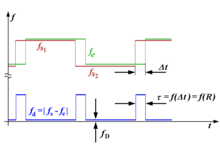
Back إبدال بإزاحة التردد Arabic ফ্রিকুয়েন্সি সিফট কিয়িং Bengali/Bangla Modulació per desplaçament de freqüència Catalan Klíčování frekvenčním posuvem Czech Frequenzumtastung German Διαμόρφωση μετατόπισης συχνότητας Greek Modulación por desplazamiento de frecuencia Spanish Sagedusmanipulatsioon Estonian کلیدزنی جابجایی-فرکانس Persian FSK Finnish
This article needs additional citations for verification. (March 2009) |
| Passband modulation |
|---|
 |
| Analog modulation |
| Digital modulation |
| Hierarchical modulation |
| Spread spectrum |
| See also |


Frequency-shift keying (FSK) is a frequency modulation scheme in which digital information is encoded on a carrier signal by periodically shifting the frequency of the carrier between several discrete frequencies.[1] The technology is used for communication systems such as telemetry, weather balloon radiosondes, caller ID, garage door openers, and low frequency radio transmission in the VLF and ELF bands. The simplest FSK is binary FSK (BFSK, which is also commonly referred to as 2FSK or 2-FSK), in which the carrier is shifted between two discrete frequencies to transmit binary (0s and 1s) information.[2]
- ^ Kennedy, G.; Davis, B. (1992). Electronic Communication Systems (4th ed.). McGraw-Hill International. ISBN 978-0-07-112672-4., p 509
- ^ FSK: Signals and Demodulation (B. Watson) http://www.xn--sten-cpa.se/share/text/tektext/digital-modulation/FSK_signals_demod.pdf Archived 2012-09-07 at the Wayback Machine
© MMXXIII Rich X Search. We shall prevail. All rights reserved. Rich X Search